Properties of Trapezoids and Kites Overview
Explore the properties of trapezoids and kites in Section 7.5. Learn to use the Trapezoid Midsegment Theorem, identify quadrilaterals, and understand key concepts such as base angles, legs, and isosceles trapezoids. Practice identifying trapezoids in the coordinate plane and solving problems related to isosceles trapezoids. Utilize the Midsegment Theorem to find midsegments of trapezoids and deepen your understanding of these geometric shapes.
Download Presentation

Please find below an Image/Link to download the presentation.
The content on the website is provided AS IS for your information and personal use only. It may not be sold, licensed, or shared on other websites without obtaining consent from the author.If you encounter any issues during the download, it is possible that the publisher has removed the file from their server.
You are allowed to download the files provided on this website for personal or commercial use, subject to the condition that they are used lawfully. All files are the property of their respective owners.
The content on the website is provided AS IS for your information and personal use only. It may not be sold, licensed, or shared on other websites without obtaining consent from the author.
E N D
Presentation Transcript
Properties of Trapezoids and Kites Section 7.5
What You Will Learn Use properties of trapezoids. Use the Trapezoid Midsegment Theorem to fi nd distances. Use properties of kites. Identify quadrilaterals.
Using Properties of Trapezoids Using Properties of Trapezoids A trapezoid is a quadrilateral with exactly one pair of parallel sides. The parallel sides are the bases. Base angles of a trapezoid are two consecutive angles whose common side is a base. A trapezoid has two pairs of base angles. For example, in trapezoid ABCD, A and D are one pair of base angles, and B and C are the second pair. The nonparallel sides are the legs of the trapezoid. If the legs of a trapezoid are congruent, then the trapezoid is an isosceles trapezoid
Identifying a Trapezoid in the Coordinate Plane Show that ORST is a trapezoid. Then decide whether it is isosceles. You Try: The points A( 5, 6), B(4, 9), C(4, 4), and D( 2, 2) form the vertices of a quadrilateral. Show that ABCD is a trapezoid. Then decide whether it is isosceles.
Using Properties of Isosceles Trapezoids The stone above the arch in the diagram is an isosceles trapezoid. Find m K, m M, and m J.
You Try 1. If EG = FH, is trapezoid EFGH isosceles? Explain. 2. If m HEF = 70 and m FGH = 110 , is trapezoid EFGH isosceles? Explain.
Using the Trapezoid Midsegment Theorem Recall that a midsegment of a triangle is a segment that connects the midpoints of two sides of the triangle. The midsegment of a trapezoid is the segment that connects the midpoints of its legs. The theorem below is similar to the Triangle Midsegment Theorem (Thm. 6.8).
Using the Using the Midsegment Midsegment of a Trapezoid of a Trapezoid In the diagram, MN is the midsegment of trapezoid PQRS. Find MN.
Using a Using a Midsegment Midsegment in the Coordinate Plane in the Coordinate Plane Find the length of midsegment YZ in trapezoid STUV.
Using Properties of Kites Using Properties of Kites A kite is a quadrilateral that has two pairs of consecutive congruent sides, but opposite sides are not congruent.
Kite Diagonals Theorem Kite Diagonals Theorem Given: ABCD is a kite, BC BA , and DC DA . Prove: AC BD
Finding Angle Measures in a Kite Finding Angle Measures in a Kite Find m D in the kite shown.
Identifying Special Quadrilaterals Identifying Special Quadrilaterals
Identifying a Quadrilateral Identifying a Quadrilateral What is the most specific name for quadrilateral ABCD?
You Try You Try























